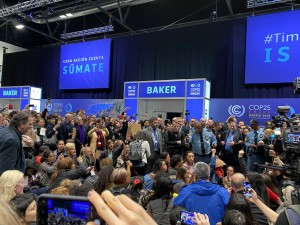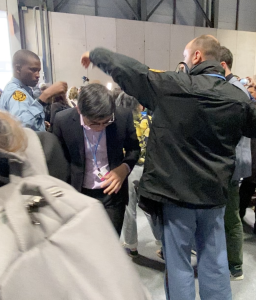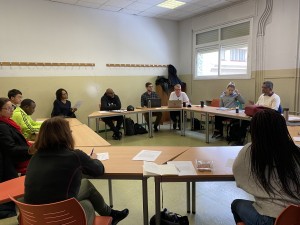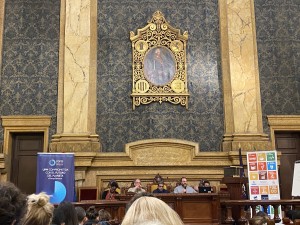Wednesday was a day of working with YOUNGO again, beginning with the spokescouncil or daily meeting in the morning, which Nancy facilitated. After this, YOUNGO had a bilateral with the President of the UN General Assembly. Bilaterals are one of the multiple ways that constituencies like YOUNGO can get involved in the negotiations, although it was difficult for me to see more to it beyond a PR move. Firstly, all interested YOUNGO members had to submit their questions beforehand so that they could be reviewed, so everything was pretty scripted. After all of the scripted questions, there were some more spontaneous ones, but since the PGA took them five at a time he was able to skip over certain topics and focus on others. Some of the questions were: What are your plans as PGA for impacting economy and security of LDCs? In 2020, what will the UN’s process be to include young people in the discussion and how will UN cater to changing needs of youth? After 25 years of having the UNFCCC negotiations, we can all see outcomes are not meeting needs of time. Don’t you think we should redesign the negotiations to facilitate more collaboration and contribution? The considerations of human rights have been sidelined in negotiations leaving many communities vulnerable… what will you do to ensure human rights and indigenous rights?
Before the meeting and bilateral Nancy had introduced me to a Haverford graduate who has been working for the UN for the past several years. I spent some time talking with him after the meeting, and we ran into someone he knew, who mentioned something called the “contra COP.” I was immediately curious. I had heard about how in Chile they were holding an alternate climate meeting, but I didn’t know there was anything like that going on in Madrid. I got some more information, and found their website, which was all in Spanish and listed all of the events they were holding that week. I decided I would try to go there that day or the next, to see what it was like.
I had heard that there would be an action that morning in front of one of the plenary rooms, protesting the removal of human rights language from the Article 6 negotiations, but when I went there, all I could see were several groups of people chatting together. Wondering if maybe they were preparing for the action and trying not to look suspicious, I asked someone, but they told me they had all just gotten out of the last event. A security guard then asked everyone to clear away.
A bit confused, I decided to go to an event I had heard about that highlighted the work of Bayer Crop Science, a soil company that was doing research on no-till farming as a method of carbon sequestration. The VP of Environment at Bayer was presenting alongside the CEO of Gold Standard, a company that produces sustainability standards for other agriculture companies, someone representing the Farmers Union of the UK and Wales, and an economist from the USDA. The highlight was Bayer’s ongoing soil research, which was being done through satellite imaging of farmer in the Midwestern United States. The satellite technology could pick up how much the soil had been tilled, and then the researchers could test the soil to see how much the carbon content in a given field’s soil corresponded with how much that field had been tilled. The USDA person also talked about their grant program CIG (Conservation Innovation Grant) which gives money to those trying to develop tools for next generation’s conservation efforts on working agricultural land, through researching or implementing market-based solutions to resource challenges. The speaker said that the key words here are working land, because it shows that conservation can happen at the farming level, not just through preserving pristine national park lands. But I also hear another key term: market based strategies, and found that throughout the panel, the narrow focus on the no-till carbon sequestration methods they were trying to develop meant that other key aspects of GHG generation from industrial agriculture, such as pollution from pesticide production, could easily be ignored.
Later that afternoon I went to the CAN meeting, where they were discussing who would be the fossil of the day for that day. They also began discussing the action that was going to be happening that day. For some background, most actions at COP are very highly regulated and have to be registered with security beforehand. This one was unauthorized. Just as someone announced this, a security guard was seen entering the meeting hall… someone said, “This is a closed meeting for CAN members only,” but it took a little bit more discussing to finally get the guard to leave. After that, the details of the protest were sent via email. The instructions were for us to stand around chatting in groups inconspicuously outside the plenary hall entrance a few minutes before the protest was supposed to start. Upon hearing the signal, a whistle, everyone was to make as much noise as possible using anything they had. I used my glass water bottle and a bamboo reusable straw, both of which had ironically been given to me in a swag bag from COP. The protest got pretty heated… there was a central group of people who were doing call and response, and I was pretty close to them when I noticed that people were starting to sit down. I saw a security guard and I thought they were probably trying to get people to sit so they could get them under control. Someone next to me said “they are going to de-badge people!”
The security guards started to form a human blockade and edge the protesters who were within their blockade towards a large garage door-like exit, which was opened. As the crowd booed, they pushed people out of the doors. They began to close the doors, but people crowded around them and booed louder, and so they began to form another blockade around those people; I was among them but I eventually slipped away before they actually formed the blockade. Many people who were in press slipped out from the blockade and were allowed, but others who tried to go under the guards’ arms were stopped. It was hectic!
I took a video, but it was too large a file to upload, so here are some screenshots of security letting someone from the press out:
and stopping others from escaping:
About 300 people were locked outside in that courtyard area, and they blocked off anyone from entering that hall for the next hour. A lot of people were de-badged, though the next day they were allowed back into the conference, after a lot of push back. It was definitely an exciting experience.
After that, I wandered around the various booths where different groups were presenting their work in video or poster format. There I met an indigenous Amazonian from Peru, and we talked about the Peruvian Amazon and the organization he was involved with. I also asked him if he felt like he was able to have a voice at COP and impact the decision making. He said not really at all in the higher-level decisions, but that it was good to be there to bring more visibility to his town and community. The next week he and others in his group were going to be speaking with the environmental Minister of Peru in Lima about a specific issue affecting the Amazon river, in which a Chinese-based company was planning to dredge the river to make it more navigable, at the risk of ecosystem collapse and the damaging of indigenous lands.






